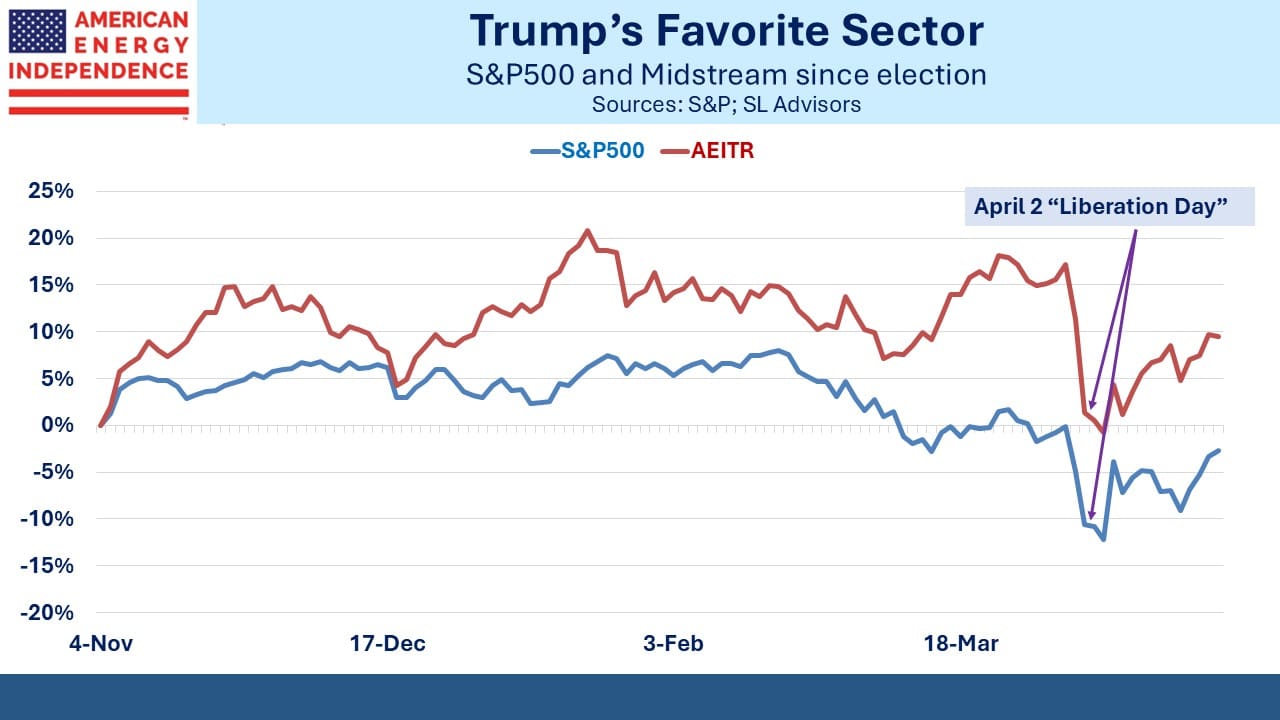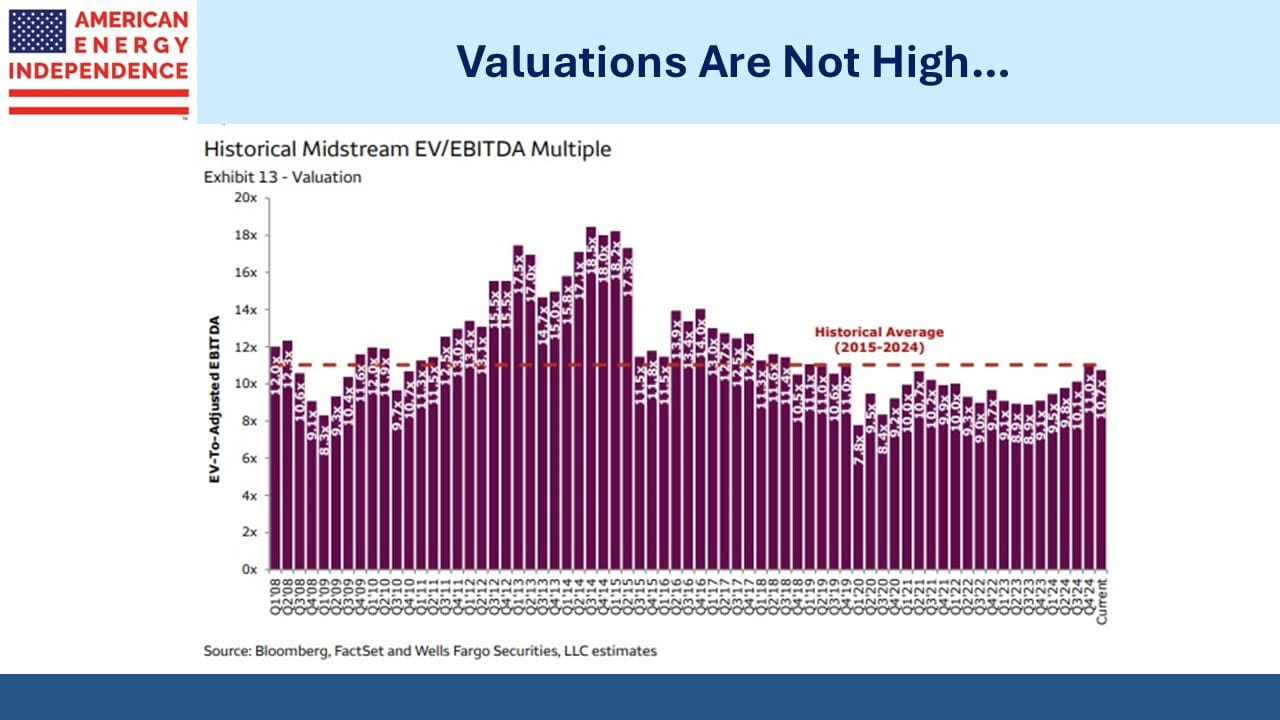Talking Midstream In the Volunteer State

/
Midstream energy infrastructure is offering solid defense during a period when Presidential ruminations on tariffs or Jay Powell’s career prospects regularly cause 2% daily market moves. Operating a pipeline business is dull by comparison. These companies are largely immune to trade wars. They just keep generating cash and raising dividends.
Last week Energy Transfer (ET) announced a distribution hike of over 3%. Western Midstream came in with 4%. Earlier in the month Kinder Morgan announced a 2% dividend hike. Enbridge reaffirmed 3% annual increases that were originally forecast in December.
It’s not just that midstream is mostly a domestic business with limited exposure to foreign markets. China was only 5% of US LNG exports last year. If they dropped to zero, we’d just ship to other countries.
Kinder Morgan estimates that more expensive steel imports will add 1% to the cost of new projects. But capex isn’t a big driver of most midstream companies’ profits anymore, in part due to persistent lawsuits from climate extremists weaponizing the legal system and causing delays. Lower capex has boosted free cash flow, supporting dividend hikes, buybacks and reduced leverage.
If you meet a climate protester (and there seem to be fewer of them nowadays), hug them and offer transportation to their next event.
When you combine this limited exposure to tariff turmoil with the inherent stability of energy volumes, it’s hard to see why the fundamental values of these companies have changed at all over the past month. So far none has revised earnings guidance.
The American Energy Independence Index (AEITR) has sustained its positive return since the election, even though it was already widely believed that Trump would be good for the energy sector. Although still down since “Liberation Day”, it has retained its outperformance versus the S&P500.
Apart from China, across the rest of Asia countries are increasing their imports of US Liquefied Natural Gas (LNG). Japan, South Korea, India, Taiwan and Vietnam have all either set new records or indicated a desire to buy more. It’s a good way to reduce their trade deficits with the US.
Last week we were in Tennessee, dubbed “The Volunteer State” for its strong tradition of military service. In Memphis my wife fulfilled a lifelong dream to visit Elvis Presley’s Graceland while I enjoyed meeting clients over lunch. The next day another client lunch in Nashville afforded a brief opportunity afterwards to visit Andrew Jackson’s Hermitage. Jackson’s consequential life included leading the American army to victory at the Battle of New Orleans, concluding the War of 1812 and ejecting the British from US soil.
I’m glad it turned out that way.
I always enjoy fielding questions from potential investors, as they often reveal concerns others may have about the sector. The meetings in Tennessee provided plenty. The upside for natural gas consumption from data centers is well understood, but nuclear power still causes some to ask whether this will become the solution of choice. The Vogtle nuclear plant in nearby Georgia took fifteen years to complete and cost more than 2X initial estimates.
We should be adding nuclear, but critics argue that the Nuclear Regulatory Commission is excessively bureaucratic and demands multiple redundant safety systems. There are always opponents able to use the court system to slow construction, raising costs and scrambling IRR projections.
Absent changes, investing in nuclear energy remains unattractive. Small Modular Reactors (SMRs) continue to inspire hope, but so far haven’t moved beyond pilot projects designed for proof of concept. Three years ago NextEra CEO John Ketchum called SMRs, “an opportunity to lose money in smaller batches.”
The impact of the LNG permit pause often draws questions. When the Biden administration imposed this in January 2024, it didn’t impact projects that were already under construction. New projects needing a permit to begin construction had to wait. Three to five years is the typical timeframe to completion, although Venture Global’s modular approach has reduced this.
Trump canceled the pause as one of his first official acts upon taking office. But as the chart from Shell shows, there never was any discernible impact on our increasing LNG export capacity.
The case for midstream continues to be underpinned by demand growth, valuation and White House support. The sector isn’t as cheap as late 2023, but Enterprise Value/EBITDA (EV/EBITDA) recently dipped back below its ten year average following the ongoing tariff turmoil. Given the positive fundamentals which include dividend hikes, amply covered payouts and declining leverage, there doesn’t seem much to prevent valuations moving higher.
Since the industry roughly finances itself with equal amounts of debt and equity, a one turn improvement in EV/EBITDA from, say, 10.7X to 11.7X (i.e. +9.3%) would push equity values up around twice that. Alternatively, adding the sector’s dividend yield (5%), long-term dividend growth (3%) and buybacks (2-3% of market cap) implies a 10-11% total return without any change in valuation.
These solid fundamentals are what’s behind strong relative performance. They remain in place.
We have two have funds that seek to profit from this environment:

Important Disclosures
The information provided is for informational purposes only and investors should determine for themselves whether a particular service, security or product is suitable for their investment needs. The information contained herein is not complete, may not be current, is subject to change, and is subject to, and qualified in its entirety by, the more complete disclosures, risk factors and other terms that are contained in the disclosure, prospectus, and offering. Certain information herein has been obtained from third party sources and, although believed to be reliable, has not been independently verified and its accuracy or completeness cannot be guaranteed. No representation is made with respect to the accuracy, completeness or timeliness of this information. Nothing provided on this site constitutes tax advice. Individuals should seek the advice of their own tax advisor for specific information regarding tax consequences of investments. Investments in securities entail risk and are not suitable for all investors. This site is not a recommendation nor an offer to sell (or solicitation of an offer to buy) securities in the United States or in any other jurisdiction.
References to indexes and benchmarks are hypothetical illustrations of aggregate returns and do not reflect the performance of any actual investment. Investors cannot invest in an index and do not reflect the deduction of the advisor’s fees or other trading expenses. There can be no assurance that current investments will be profitable. Actual realized returns will depend on, among other factors, the value of assets and market conditions at the time of disposition, any related transaction costs, and the timing of the purchase. Indexes and benchmarks may not directly correlate or only partially relate to portfolios managed by SL Advisors as they have different underlying investments and may use different strategies or have different objectives than portfolios managed by SL Advisors (e.g. The Alerian index is a group MLP securities in the oil and gas industries. Portfolios may not include the same investments that are included in the Alerian Index. The S & P Index does not directly relate to investment strategies managed by SL Advisers.)
This site may contain forward-looking statements relating to the objectives, opportunities, and the future performance of the U.S. market generally. Forward-looking statements may be identified by the use of such words as; “believe,” “expect,” “anticipate,” “should,” “planned,” “estimated,” “potential” and other similar terms. Examples of forward-looking statements include, but are not limited to, estimates with respect to financial condition, results of operations, and success or lack of success of any particular investment strategy. All are subject to various factors, including, but not limited to general and local economic conditions, changing levels of competition within certain industries and markets, changes in interest rates, changes in legislation or regulation, and other economic, competitive, governmental, regulatory and technological factors affecting a portfolio’s operations that could cause actual results to differ materially from projected results. Such statements are forward-looking in nature and involves a number of known and unknown risks, uncertainties and other factors, and accordingly, actual results may differ materially from those reflected or contemplated in such forward-looking statements. Prospective investors are cautioned not to place undue reliance on any forward-looking statements or examples. None of SL Advisors LLC or any of its affiliates or principals nor any other individual or entity assumes any obligation to update any forward-looking statements as a result of new information, subsequent events or any other circumstances. All statements made herein speak only as of the date that they were made. r
Certain hyperlinks or referenced websites on the Site, if any, are for your convenience and forward you to third parties’ websites, which generally are recognized by their top level domain name. Any descriptions of, references to, or links to other products, publications or services does not constitute an endorsement, authorization, sponsorship by or affiliation with SL Advisors LLC with respect to any linked site or its sponsor, unless expressly stated by SL Advisors LLC. Any such information, products or sites have not necessarily been reviewed by SL Advisors LLC and are provided or maintained by third parties over whom SL Advisors LLC exercise no control. SL Advisors LLC expressly disclaim any responsibility for the content, the accuracy of the information, and/or quality of products or services provided by or advertised on these third-party sites.
All investment strategies have the potential for profit or loss. Different types of investments involve varying degrees of risk, and there can be no assurance that any specific investment will be suitable or profitable for a client’s investment portfolio.
Past performance of the American Energy Independence Index is not indicative of future returns.






Leave a Reply
Want to join the discussion?Feel free to contribute!